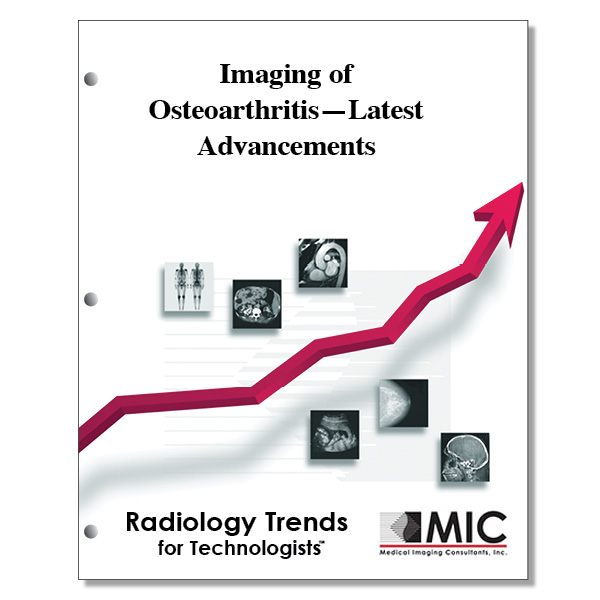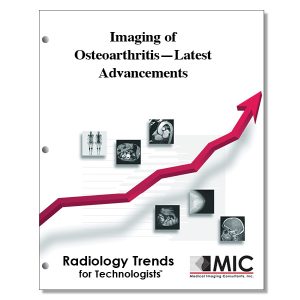

Imaging of Osteoarthritis—Latest Advancements
An updated review of the many recent developments in imaging of osteoarthritis.
Course ID: Q00624 Category: Radiology Trends for Technologists Modalities: CT, MRI, Nuclear Medicine, Radiography, Sonography3.0 |
Satisfaction Guarantee |
$34.00
- Targeted CE
- Outline
- Objectives
Targeted CE per ARRT’s Discipline, Category, and Subcategory classification:
[Note: Discipline-specific Targeted CE credits may be less than the total Category A credits approved for this course.]
Computed Tomography: 0.50
Procedures: 0.50
Head, Spine, and Musculoskeletal: 0.50
Magnetic Resonance Imaging: 1.25
Procedures: 1.25
Musculoskeletal: 1.25
Nuclear Medicine Technology: 0.25
Procedures: 0.25
Other Imaging Procedures: 0.25
Radiography: 0.50
Procedures: 0.50
Extremity Procedures: 0.50
Registered Radiologist Assistant: 1.25
Procedures: 1.25
Musculoskeletal and Endocrine Sections: 1.25
Sonography: 0.50
Procedures: 0.50
Superficial Structures and Other Sonographic Procedures: 0.50
Outline
- Introduction
- Radiography
- US Imaging
- CT Imaging
- Nuclear Medicine
- Semiquantitative MRI Assessment
- Quantitative MRI Analysis of Articular Cartilage
- Compositional MRI
- Artificial Intelligence in MRI Assessment
- Other Joints, Beyond the Knee
- Treatments for OA
- Outlook for OA
Objectives
Upon completion of this course, students will:
- describe the estimated proportion of the population aged 45 years or older that will have physician-diagnosed knee OA
- list the factors that may play an important role in the early stages of osteoarthritis
- identify the imaging modality that has traditionally been used to assess osteoarthritis structural changes
- identify the most important imaging modality used to evaluate osteoarthritis in a research context
- describe the imaging features associated with the different grades of the Kellgren-Lawrence grading scheme
- describe the most widely applied radiographic criterion for defining the presence of structural osteoarthritis
- identify the Kellgren-Lawrence grade of OA associated with a definite osteophyte on radiographs
- describe the use of imaging in phase III clinical trials of OA drugs
- identify the radiographic view commonly used to visualize joint space narrowing in the knee
- list the strengths of US over other modalities in the assessment of OA
- describe the sensitivity of US imaging over radiography in the evaluation of abnormalities in the knee
- identify the CT imaging technique that can discriminate meniscal calcium pyrophosphate deposits from calcium hydroxyapatite
- describe the temporal resolution of four-dimensional CT used for kinematic CT acquisitions of the knee
- identify the CT technique that requires the intra-articular injection of contrast material
- list the knee structures which can be assessed accurately with CT arthrography
- describe the usefulness of PET imaging in the setting of OA
- identify the imaging modality that does not play a role in the diagnosis and decision-making processes of knee OA
- describe the first published MRI scoring system that has been used extensively for almost 2 decades in a multitude of OA studies worldwide
- list the semiquantitative MRI scoring systems that assess cartilage size and depth on a scale from 0 to 3
- list the semiquantitative MRI scoring systems that include assessment of the Hoffa fat pad for synovitis
- list the three main structural phenotypes of OA
- identify the semiquantitative MRI scoring system that can achieve phenotypic characterization of OA based on a simplified MRI assessment
- list the compositional MRI techniques that assess glycosaminoglycans in cartilage
- list the compositional MRI techniques that can be limited by magic angle effects
- describe the location of regional cartilage thickening that may be an early event in OA pathophysiology
- list the OA treatments that are evaluated using quantitative MRI measurements of cartilage volume and thickness change
- identify the compositional MRI techniques that have been used to evaluate OA in most research studies
- describe the use of compositional MRI using T2 quantification in the assessment of OA
- identify the body joints where T1r mapping has been shown to be a predictor of OA progression.
- list the tissues that have been successfully segmented using deep learning approaches in fully automated MRI segmentation
- describe the use of deep learning methods to assign grades to assess OA severity on knee radiographs
- list the OA-associated structural joint pathologies that can be identified by MRI deep learning approaches
- describe subtle but clinically relevant changes at MRI that may be missed by deep learning neural networks
- list the reasons why less attention has been paid to imaging OA in the hip
- describe the evaluation focus of the Hip Inflammation MRI Scoring System
- identify the imaging techniques that can assess the biochemical composition of cartilage
- identify the imaging techniques associated with a long imaging time
- describe the compositional MRI technique used to evaluate the hip prior to acetabular osteotomy in patients with developmental hip dysplasia
- describe treatments for OA based on the recommended hierarchy of management
- identify the class of drugs associated with safety concerns during clinical trials
